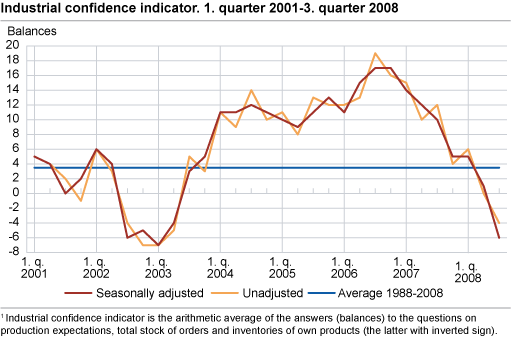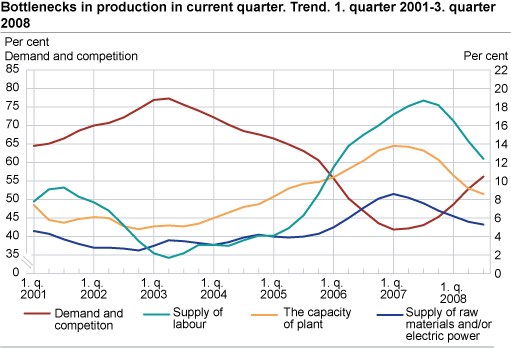Content
Published:
This is an archived release.
A change of pace in the manufacturing industry
Norwegian industrial managers report a slowdown in total output, but the overall picture is somewhat mixed.
According to the business tendency survey1, the Norwegian manufacturing industry experienced a slowdown in total output in the third quarter. Poor results for industries that rely on demand from the construction business are the main reason for this development. Total stocks of orders fell due to a decline in new orders from domestic and export markets, while market prices continued to rise. A weaker Norwegian currency and higher costs due to rising prices of input factors are likely explanations for this development. Bottlenecks in the production (see table 16 ) still pose a major concern in some industries, but shortage of qualified labour seems to be less important than in the first two quarters of the year. At the same time there is an increase in the number of managers reporting that weak demand and growing competition are limiting production factors. The number of working months covered by the current stock of orders is somewhat lower than the corresponding figure for 2007. The average capacity utilisation is estimated to be 83 per cent. International comparisons of average capacity utilisation are available from EUROSTAT .
The indicator covering the general short-term outlook is changing from positive to negative. Expectations of weaker demand from export markets support this result. The turbulence in international financial markets may also influence the judgment of the short-term outlook. The industrial confidence indicator is estimated at -6 (seasonally-adjusted net figure) in the third quarter. This is well below the historic average and indicates a change in the business cycle. International comparisons of the industrial confidence indicator are available from EUROSTAT (EU) and the Swedish National Institute of Economic Research (Sweden).
Lower demand from construction
Sectors producing intermediate goods (wood and wood products, pulp, paper and paper products, the chemical industry, basic metals and so on) experienced a decline in output and employment, but the overall picture is somewhat mixed. Producers of wood and wood products and other non-metallic mineral products seem to be affected by a slowdown in the construction business and contribute to the poorer results. Market prices continue to grow in spite of a decline in new orders. It is likely that a weaker Norwegian currency contributes to this development. The number of working months covered by the current stock of orders is somewhat lower than the corresponding figures for 2007. Average capacity utilisation is estimated to be 82 per cent in the third quarter.
A higher number of the industrial managers consider the general short-term outlook to be negative. Expectations of a decline in employment and new orders support this result.
High stocks of new orders secures growth in total output
Sectors producing capital goods (machinery and equipment, offshore-related activity and so on) experienced a moderate increase in output and employment. Total stocks of orders fell due to a decline in new orders from domestic and export markets, while market prices continued to rise. Higher costs due to rising prices of input factors contribute to this development. A shortage of qualified labour still poses a major challenge for the industries in question. However, lack of capacity no longer seems to constitute a major problem. The number of working months covered by the current stock of orders is somewhat lower than recorded one year ago, but remains at a very high level. Average capacity utilisation is estimated to be 87.8 per cent in the third quarter.
Fewer industrial managers consider the general short-term outlook to be better, but those who share this opinion are still in the majority. The fact that the industrial managers are considering a reduction in planned gross capital investments might be interpreted as a sign of negative prospects in the long run.
Strong growth in prices of consumer goods
Sectors producing consumer goods (like the food industry, publishing, pharmaceutical industry and so on) experienced a rise in total output. High demand in domestic markets explains this result. Market prices continued to rise. A strong growth in prices of food products was the main reason for this development. Average capacity utilisation is estimated at 79.6 per cent in the third quarter.
A majority of the respondents consider the general short-term outlook to be better. Prospects of a further increase in demand and market prices support this result.
1 Survey data are collected in the period 10 September to 20 October. Consequently, both before and after the international financial crisis had fully taken off.
| Industry | Prospects | Background | |||||||||||||||||||||||||||||||||||||
|---|---|---|---|---|---|---|---|---|---|---|---|---|---|---|---|---|---|---|---|---|---|---|---|---|---|---|---|---|---|---|---|---|---|---|---|---|---|---|---|
| Food products, beverages and tobacco | ++ | Growth in output, capacity utilisation and employment. Increase in demand from the domestic market, while demand from the export market is reduced. Higher market prices, especially in the domestic market. The general outlook for Q4 is considered to be better by many managers, and the positive development in production and demand is expected to continue. A further increase in market prices is expected in the forthcoming quarter. | |||||||||||||||||||||||||||||||||||||
| Wood and products of wood | -- | Many managers report lower levels of production, capacity utilisation and employment. Decline in new orders from the domestic and export market. Many managers report that weak demand and growing competition in the domestic market limits production. Many managers consider the general outlook for Q4 as worse. Further decline in output, employment and new orders are expected. Market prices are expected to be lower in the forthcoming quarter. | |||||||||||||||||||||||||||||||||||||
| Pulp, paper and paper products | + | Increases in production and capacity utilisation in Q3, while employment is reduced. Rise in new orders from the domestic market, while export orders are down. Rising export market prices. The general outlook for Q4 is judged as better, and growth in output, new orders and prices is expected. | |||||||||||||||||||||||||||||||||||||
| Basic chemicals | + | More or less unchanged levels of production and capacity utilisation. Growth in employment. Increase in new orders from the domestic and export market. Shortage of capacity limits production. The general outlook for the forthcoming quarter is considered as positive. Increases in output, new orders and market prices are expected in Q4. Employment is expected to decline. | |||||||||||||||||||||||||||||||||||||
| Basic metals, non-ferrous | - | More or less unchanged level of production. Reduced levels of employment, new orders and market prices. The general outlook for Q4 is judged as worse. Output is expected to be more or less unchanged, but employment to rise. The managers expect the level of new orders to be lower. The same is the case for the market prices. | |||||||||||||||||||||||||||||||||||||
| Engineering, total | + | Overall, the engineering industries report increased levels of production and employment. Decline in new orders from the domestic and export market. Rise in domestic and export market prices. Many managers still report that lack of qualified labour limits production, but fewer than in the previous survey share this opinion. The general outlook is considered as better, and further increases in output, employment and prices are expected. The level of new orders is also expected to rise in Q4. | |||||||||||||||||||||||||||||||||||||
| Metal products | -(+) | Continued growth in output. More or less unchanged level of capacity utilisation and employment. The total stock of orders is reduced. Fewer managers report that lack of qualified labour limits production. The general outlook is judged as worse, and reduced levels of production, employment and new orders are expected in Q4. Market prices are expected to rise. | |||||||||||||||||||||||||||||||||||||
| Machinery and equipment | ++ | Many managers still report a high level of activity. Growth in output, capacity utilisation and employment. Rise in new orders and prices. The general outlook is considered as better, but fewer managers than in the previous survey share this opinion. Further increases in output, employment and prices are expected in Q4. New orders from the domestic market are expected to be more or less unchanged, while export orders are expected to rise. | |||||||||||||||||||||||||||||||||||||
| Electrical and optical equipment | + | Higher levels of production, capacity utilisation and employment. Rise in new orders from the export market, while new orders from the domestic market are lower. Increase in market prices. Fewer managers than in the previous survey report that lack of qualified labour limits production, while an increasing number report weak demand as a limiting factor. The general outlook is judged as worse. Output and employment are expected to increase, while new orders and prices are expected to be at the same level as in Q3. | |||||||||||||||||||||||||||||||||||||
| Offshore-related activity incl. transport industry | + | Increases in output and capacity utilisation. More or less unchanged level of employment. Decline in new orders from the domestic and export market. Domestic market prices have risen, while export prices are more or less unchanged. Lack of qualified labour is still a major limiting factor for production, but fewer managers than in the previous survey support this view. The general outlook for Q4 is judged as better, and output, stock of orders and domestic market prices are expected to rise. Employment and export market prices are expected to be more or less unchanged. | |||||||||||||||||||||||||||||||||||||
| The column for Prospects shows an overall evaluation of the present situation and expected short-term developments using the symbols + and -. The following codes and constellations are used: |
++
+ ² - -- -(+) +/- |
Very good
Good Stable Weak Very weak Weak, but with certain positive indications A situation where the + and - factors even out. |
|||||||||||||||||||||||||||||||||||||
Additional information
The statistics provide current data on the business cycle for manufacturing, mining and quarrying by collecting business leaders’ assessments of the economic situation and the short term outlook.
Contact
-
Edvard Andreassen
E-mail: edvard.andreassen@ssb.no
tel.: (+47) 40 90 23 32
-
Ståle Mæland
E-mail: stale.maeland@ssb.no
tel.: (+47) 95 05 98 88


